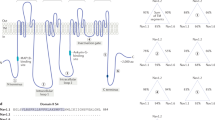Abstract
In all eukaryotic cells, the cytosolic concentration of calcium ions ([Ca2+]c) is tightly controlled by complex interactions among transporters, pumps, channels and binding proteins. Finely tuned changes in [Ca2+]c modulate a variety of intracellular functions, and disruption of Ca2+ handling leads to cell death. Here we review the human genetic diseases associated with perturbations in the Ca2+ signaling machinery. Despite the importance of Ca2+ in physiology and pathology, the number of known genetic diseases that can be attributed to defects in proteins directly involved in Ca2+ homeostasis is limited to few examples, which will be discussed. This paucity in contrast with the wide molecular repertoire may depend on the extreme severity of the phenotype (leading to death in utero) or, conversely, on functional compensation due to redundancy. In the latter case, it stands to reason that other genetic defects in calcium signaling have yet to be identified owing to their subtle phenotype.
This is a preview of subscription content, access via your institution
Access options
Subscribe to this journal
Receive 12 print issues and online access
$209.00 per year
only $17.42 per issue
Buy this article
- Purchase on Springer Link
- Instant access to full article PDF
Prices may be subject to local taxes which are calculated during checkout

Similar content being viewed by others
References
Berridge, M.J., Lipp, P. & Bootman, M.D. The versatility and universality of calcium signaling. Nat. Rev. Mol. Cell Biol. 1, 11–21 (2000).
Pozzan, T., Rizzuto, R., Volpe, P. & Meldolesi, J. Molecular and cellular physiology of intracellular calcium stores. Physiol. Rev. 74, 595–636 (1994).
Clapham, D.E. Sorting out MIC, TRP, and CRAC ion channels. J. Gen. Physiol. 120, 217–220 (2002).
Pinton, P., Pozzan, T. & Rizzuto, R. The Golgi apparatus is an inositol 1,4,5-trisphosphate-sensitive Ca2+ store, with functional properties distinct from those of the endoplasmic reticulum. EMBO J. 17, 5298–5308 (1998).
Schmidt, M. et al. A new phospholipase-C-calcium signaling pathway mediated by cyclic AMP and a Rap GTPase. Nat. Cell Biol. 3, 1020–1024 (2001).
Yoo, A.S. et al. Presenilin-mediated modulation of capacitative calcium entry. Neuron 27, 561–572 (2000).
Leissring, M.A. et al. Capacitative calcium entry deficits and elevated luminal calcium content in mutant presenilin-1 knockin mice. J. Cell Biol. 149, 793–798 (2000).
Pinton, P. et al. Reduced loading of intracellular Ca2+ stores and downregulation of capacitative Ca2+ influx in Bcl-2-overexpressing cells. J. Cell Biol. 148, 857–862 (2000).
Rizzuto, R. et al. Close contacts with the endoplasmic reticulum as determinants of mitochondrial Ca2+ responses. Science 280, 1763–1766 (1998).
Jouaville, L.S., Pinton, P., Bastianutto, C., Rutter, G.A. & Rizzuto, R. Regulation of mitochondrial ATP synthesis by calcium: evidence for a long-term metabolic priming. Proc. Natl. Acad. Sci. USA 96, 13807–13812 (1999).
Pinton, P. et al. The Ca2+ concentration of the endoplasmic reticulum is a key determinant of ceramide-induced apoptosis: significance for the molecular mechanism of Bcl-2 action. EMBO J. 20, 2690–2701 (2001).
Panov, A.V. et al. Early mitochondrial calcium defects in Huntington's disease are a direct effect of polyglutamines. Nat. Neurosci. 5, 731–736 (2002).
Brini, M. et al. A calcium signaling defect in the pathogenesis of a mitochondrial DNA inherited oxidative phosphorylation deficiency. Nat. Med. 5, 951–954 (1999).
Melzer, W., Herrmann-Frank, A. & Luttgau, H.C. The role of Ca2+ ions in excitation-contraction coupling of skeletal muscle fibres. Biochim. Biophys. Acta 1241, 59–116 (1995).
Franzini-Armstrong, C. & Protasi, F. Ryanodine receptors of striated muscles: a complex channel capable of multiple interactions. Physiol. Rev. 77, 699–729 (1997).
MacLennan, D.H. & Phillips, M.S. Malignant hyperthermia. Science 256, 789–794 (1992).
Zhang, Y. et al. A mutation in the human ryanodine receptor gene associated with central core disease. Nat. Genet. 5, 46–50 (1993).
Quane, K.A. et al. Detection of a novel mutation at amino acid position 614 in the ryanodine receptor in malignant hyperthermia. Br. J. Anaesth. 79, 332–337 (1997).
Fujii, J. et al. Identification of a mutation in porcine ryanodine receptor associated with malignant hyperthermia. Science 253, 448–451 (1991).
Mickelson, J.R. & Louis, C.F. Malignant hyperthermia: excitation–contraction coupling, Ca2+ release channel, and cell Ca2+ regulation defects. Physiol. Rev. 76, 537–592 (1996).
Loke, J. & MacLennan, D.H. Malignant hyperthermia and central core disease: disorders of Ca2+ release channels. Am. J. Med. 104, 470–486 (1998).
Monnier, N., Procaccio, V., Stieglitz, P. & Lunardi, J. Malignant-hyperthermia susceptibility is associated with a mutation of the α1-subunit of the human dihydropyridine-sensitive L-type voltage-dependent calcium-channel receptor in skeletal muscle. Am. J. Hum. Genet. 60, 1316–1325 (1997).
Dirksen, R.T. & Avila, G. Altered ryanodine receptor function in central core disease: leaky or uncoupled Ca2+ release channels? Trends Cardiovasc. Med. 12, 189–197 (2002).
MacLennan, D.H. Ca2+ signaling and muscle disease. Eur. J. Biochem. 267, 5291–5297 (2000).
Turner, P.R., Westwood, T., Regen, C.M. & Steinhardt, R.A. Increased protein degradation results from elevated free calcium levels found in muscle from mdx mice. Nature 335, 735–738 (1988).
Robert, V. et al. Alteration in calcium handling at the subcellular level in mdx myotubes. J. Biol. Chem. 276, 4647–4651 (2001).
Lynch, P.J. et al. A mutation in the transmembrane/luminal domain of the ryanodine receptor is associated with abnormal Ca2+ release channel function and severe central core disease. Proc. Natl. Acad. Sci. USA 96, 4164–4169 (1999).
Avila, G., O'Brien, J.J. & Dirksen, R.T. Excitation–contraction uncoupling by a human central core disease mutation in the ryanodine receptor. Proc. Natl. Acad. Sci. USA 98, 4215–4220 (2001).
Sternberg, D. et al. Hypokalaemic periodic paralysis type 2 caused by mutations at codon 672 in the muscle sodium channel gene SCN4A. Brain 124, 1091–1099 (2001).
Dias Da Silva, M.R., Cerutti, J.M., Arnaldi, L.A. & Maciel, R.M. A mutation in the KCNE3 potassium channel gene is associated with susceptibility to thyrotoxic hypokalemic periodic paralysis. J. Clin. Endocrinol. Metab. 87, 4881–4884 (2002).
Rajabally, Y.A. & El Lahawi, M. Hypokalemic periodic paralysis associated with malignant hyperthermia. Muscle Nerve 25, 453–455 (2002).
Brody, I.A. Muscle contracture induced by exercise. A syndrome attributable to decreased relaxing factor. N. Engl. J. Med. 281, 187–192 (1969).
Karpati, G., Charuk, J., Carpenter, S., Jablecki, C. & Holland, P. Myopathy caused by a deficiency of Ca2+-adenosine triphosphatase in sarcoplasmic reticulum (Brody's disease). Ann. Neurol. 20, 38–49 (1986).
Odermatt, A. et al. Mutations in the gene encoding SERCA1, the fast-twitch skeletal muscle sarcoplasmic reticulum Ca2+ ATPase, are associated with Brody disease. Nat. Genet. 14, 191–194 (1996).
Odermatt, A. et al. The mutation of Pro789 to Leu reduces the activity of the fast-twitch skeletal muscle sarco(endo)plasmic reticulum Ca2+ ATPase (SERCA1) and is associated with Brody disease. Hum. Genet. 106, 482–491 (2000).
Tiso, N. et al. Identification of mutations in the cardiac ryanodine receptor gene in families affected with arrhythmogenic right ventricular cardiomyopathy type 2 (ARVD2). Hum. Mol. Genet. 10, 189–194 (2001).
Priori, S.G. et al. Mutations in the cardiac ryanodine receptor gene (hRyR2) underlie catecholaminergic polymorphic ventricular tachycardia. Circulation 103, 196–200 (2001).
Tiso, N. et al. The binding of the RyR2 calcium channel to its gating protein FKBP12.6 is oppositely affected by ARVD2 and VTSIP mutations. Biochem. Biophys. Res. Commun. 299, 594–598 (2002).
Marx, S.O. et al. PKA phosphorylation dissociates FKBP12.6 from the calcium release channel (ryanodine receptor): defective regulation in failing hearts. Cell 101, 365–376 (2000).
Hatakeyama, S. et al. Differential nociceptive responses in mice lacking the α1B subunit of N-type Ca2+ channels. Neuroreport 12, 2423–2427 (2001).
Brusa, R. et al. Early-onset epilepsy and postnatal lethality associated with an editing-deficient GluR-B allele in mice. Science 270, 1677–1680 (1995).
Zuo, J. et al. Neurodegeneration in Lurcher mice caused by mutation in delta2 glutamate receptor gene. Nature 388, 769–773 (1997).
Strom, T.M. et al. An L-type calcium-channel gene mutated in incomplete X-linked congenital stationary night blindness. Nat. Genet. 19, 260–263 (1998).
Bech-Hansen, N.T. et al. Loss-of-function mutations in a calcium-channel α1-subunit gene in Xp11.23 cause incomplete X-linked congenital stationary night blindness. Nat. Genet. 19, 264–267 (1998).
Pietrobon, D. Calcium channels and channelopathies of the central nervous system. Mol. Neurobiol. 25, 31–50 (2002).
Boycott, K.M. et al. A summary of 20 CACNA1F mutations identified in 36 families with incomplete X-linked congenital stationary night blindness, and characterization of splice variants. Hum. Genet. 108, 91–97 (2001).
Catterall, W.A. Structure and regulation of voltage-gated Ca2+ channels. Annu. Rev. Cell Dev. Biol. 16, 521–555 (2000).
Tottene, A. et al. Familial hemiplegic migraine mutations increase Ca2+ influx through single human CaV2.1 channels and decrease maximal CaV2.1 current density in neurons. Proc. Natl. Acad. Sci. USA 99, 13284–13289 (2002).
Jouvenceau, A. et al. Human epilepsy associated with dysfunction of the brain P/Q-type calcium channel. Lancet 358, 801–807 (2001).
Guida, S. et al. Complete loss of P/Q calcium channel activity caused by a CACNA1A missense mutation carried by patients with episodic ataxia type 2. Am. J. Hum. Genet. 68, 759–764 (2001).
Wappl, E. et al. Functional consequences of P/Q-type Ca2+ channel Cav2.1 missense mutations associated with episodic ataxia type 2 and progressive ataxia. J. Biol. Chem. 277, 6960–6966 (2002).
Margolis, R.L. The spinocerebellar ataxias: order emerges from chaos. Curr. Neurol. Neurosci. Rep. 2, 447–456 (2002).
Toru, S. et al. Spinocerebellar ataxia type 6 mutation alters P-type calcium channel function. J. Biol. Chem. 275, 10893–10898 (2000).
Piedras-Renteria, E.S. et al. Increased expression of α1A Ca2+ channel currents arising from expanded trinucleotide repeats in spinocerebellar ataxia type 6. J. Neurosci. 21, 9185–9193 (2001).
Sakuntabhai, A. et al. Mutations in ATP2A2, encoding a Ca2+ pump, cause Darier disease. Nat. Genet. 21, 271–277 (1999).
Hu, Z. et al. Mutations in ATP2C1, encoding a calcium pump, cause Hailey–Hailey disease. Nat. Genet. 24, 61–65 (2000).
Sudbrak, R. et al. Hailey–Hailey disease is caused by mutations in ATP2C1 encoding a novel Ca2+ pump. Hum. Mol. Genet. 9, 1131–1140 (2000).
Periz, G. & Fortini, M.E. Ca2+-ATPase function is required for intracellular trafficking of the Notch receptor in Drosophila. EMBO J. 18, 5983–5993 (1999).
Egan, M.E. et al. Calcium-pump inhibitors induce functional surface expression of Delta F508-CFTR protein in cystic fibrosis epithelial cells. Nat. Med. 8, 485–492 (2002).
Mesaeli, N. et al. Calreticulin is essential for cardiac development. J. Cell Biol. 144, 857–868 (1999).
Graef, I.A., Chen, F., Chen, L., Kuo, A. & Crabtree, G.R. Signals transduced by Ca2+/calcineurin and NFATc3/c4 pattern the developing vasculature. Cell 105, 863–875 (2001).
Koulen, P. et al. Polycystin-2 is an intracellular calcium release channel. Nat. Cell Biol. 4, 191–197 (2002).
Walder, R.Y. et al. Mutation of TRPM6 causes familial hypomagnesemia with secondary hypocalcemia. Nat. Genet. 31, 171–174 (2002).
Schlingmann, K.P. et al. Hypomagnesemia with secondary hypocalcemia is caused by mutations in TRPM6, a new member of the TRPM gene family. Nat. Genet. 31, 166–170 (2002).
Futatsugi, A. et al. Facilitation of NMDAR-independent LTP and spatial learning in mutant mice lacking ryanodine receptor type 3. Neuron 24, 701–713 (1999).
Balschun, D. et al. Deletion of the ryanodine receptor type 3 (RyR3) impairs forms of synaptic plasticity and spatial learning. EMBO J. 18, 5264–5273 (1999).
Catterall, W.A. Structure and regulation of voltage-gated Ca2+ channels. Annu. Rev. Cell Dev. Biol. 16, 521–555 (2000).
Ertel, E.A. et al. Nomenclature of voltage-gated calcium channels. Neuron 25, 533–535 (2000).
Acknowledgements
We thank G. Cortopassi and M. Brini for critically reading the manuscript. The original work by the authors has been supported by grants from Italian Telethon, Italian Association for Cancer Research, the Italian Ministry of University, the National Research Council, the Human Frontier Science Program, The Italian Space Agency and the European Union.
Author information
Authors and Affiliations
Corresponding author
Rights and permissions
About this article
Cite this article
Rizzuto, R., Pozzan, T. When calcium goes wrong: genetic alterations of a ubiquitous signaling route. Nat Genet 34, 135–141 (2003). https://doi.org/10.1038/ng0603-135
Issue Date:
DOI: https://doi.org/10.1038/ng0603-135
This article is cited by
-
The ryanodine receptor mutational characteristics and its indication for cancer prognosis
Scientific Reports (2022)
-
Neuroinflammation is induced by tongue-instilled ZnO nanoparticles via the Ca2+-dependent NF-κB and MAPK pathways
Particle and Fibre Toxicology (2018)
-
Generation and validation of novel adeno-associated viral vectors for the analysis of Ca2+ homeostasis in motor neurons
Scientific Reports (2017)
-
Dantrolene improves in vitro structural changes induced by serum from Trypanosoma cruzi-infected mice
Parasitology Research (2017)
-
Remodeling of calcium signaling in tumor progression
Journal of Biomedical Science (2013)



